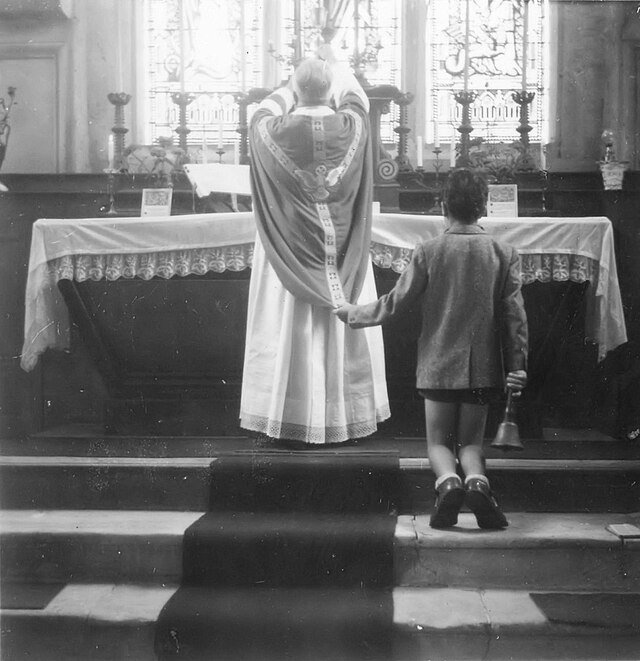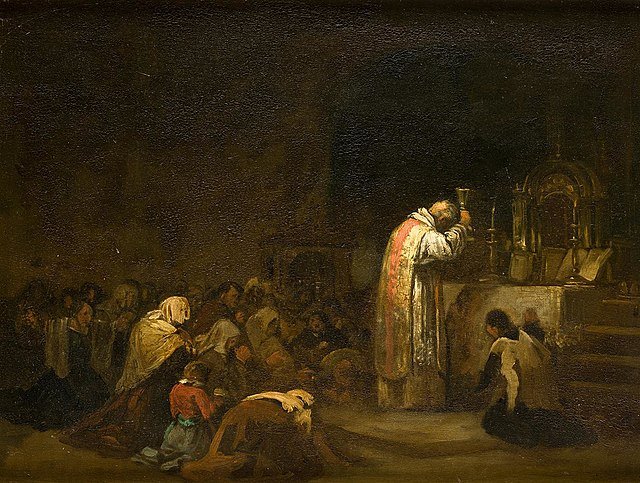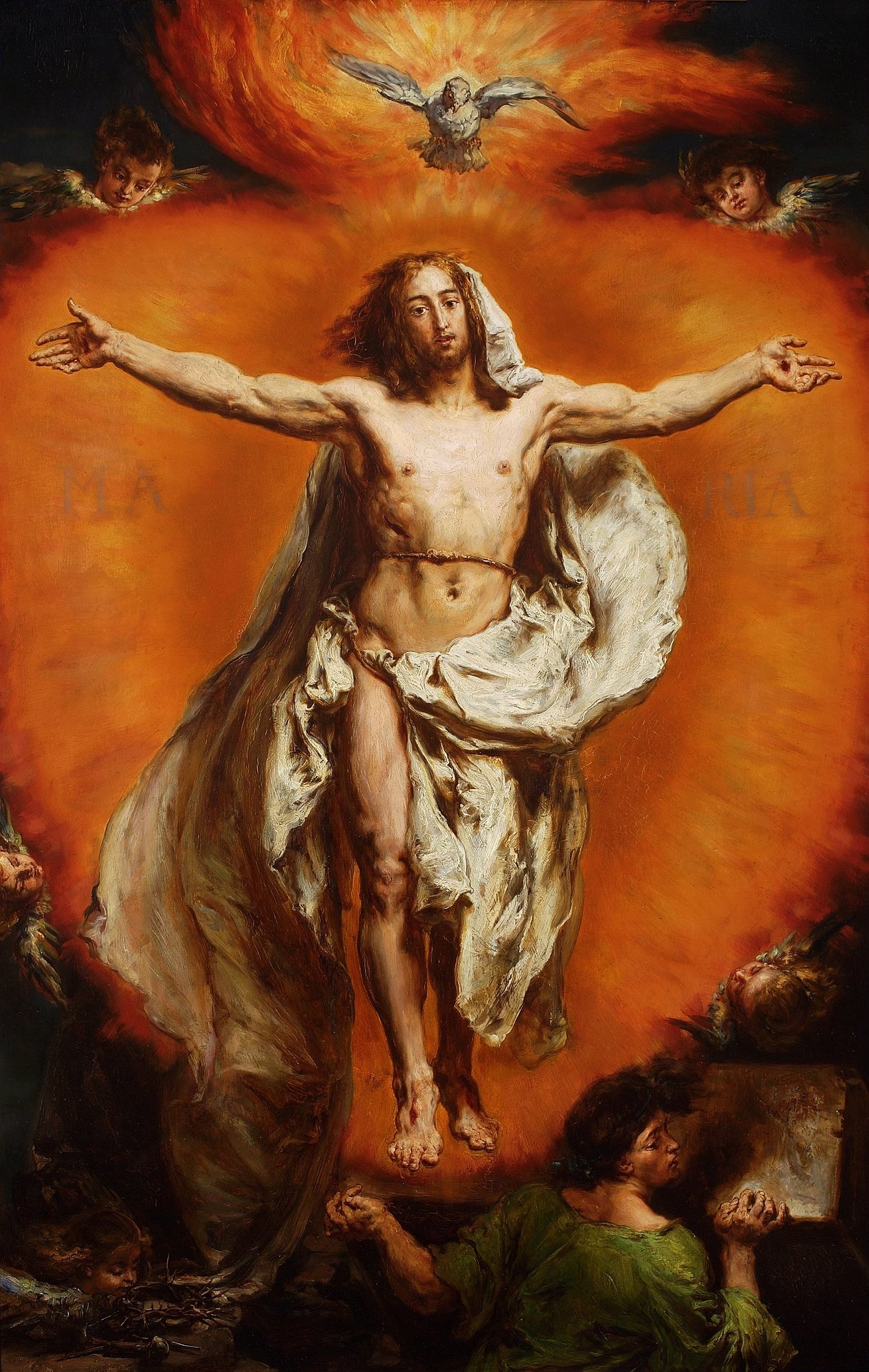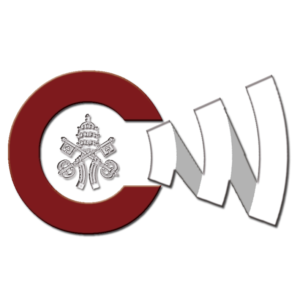Excerpts From a Conference Given by Fr. Mateo Crawley-Boevey, SS.CC, at a Benedictine Convent in April, 1944
The great Cardinal Mercier, a saintly man and a great theologian, used to say: “Give me a priest who fully appreciates the gift of his daily Mass, who relishes his Mass at the altar, never rushing, who lives the grace of his Mass, and I say to you, that priest will die one day — not good, not excellent, but a saint to be canonized.” I apply that now to all of you. If you fully realize the doctrine, the theology of the Holy Sacrifice of the Mass, living, really and truly, the grace of your daily Mass, when you die you will be not simply good, not simply excellent, but worthy of being canonized one day.

I am preaching the reign of the Sacred Heart, but the reign of the Sacred Heart supposes an enlightened mind, enlightened with a full appreciation of Holy Mass. Alas, this full appreciation is not found very often. One day our Lord appeared to a privileged soul, and the soul said to Him: “What can I offer Thee, Lord, for the glory of Thy Father, for Thy own glory, for my sanctification, for souls entrusted to me? Tell me, Jesus, what can I offer?” What did Jesus answer? “One more Mass,” He said, “For My Father, for Me, for you, for souls — one more Mass.” Let us, then, speak strongly and clearly about the Holy Mass. May Our Lady, the Queen of the Blessed Sacrament, cover you and me with her mantle of roses and of fire that we may grasp and understand this theology.
Which is the Doctrinal Priority, Holy Mass or Holy Communion?
Remark that I start speaking of the Holy Sacrifice of the Mass and not of Holy Communion. Why? Because Holy Mass is the fountain, Communion is the torrent. Number one, the chalice; number two, the altar rails. Don’t change the order. It is very sad indeed that rather often we separate the Sacrifice of the Mass from the sacrament of Holy Communion and adoration. We even give the first place to Holy Communion. This shows a lack of doctrine, of basic catechism.
Keep, then, the doctrinal scale of values: first, by far, is the chalice on the altar; secondly, come the altar rails and the tabernacle. Remember this: there is no Mass without Holy Communion, at least that of the priest. But neither is there Holy Communion for the priest nor for you without the fountain, the chalice, Holy Mass. A great archbishop whom I knew and admired very much, when organizing a Eucharistic Congress in his diocese, said to his priests, “We are now going to spend a week preaching a mission in all the parishes to honor the Eucharist. But if you preach ten times, preach eight times at least on the Mass, and two times Communion and adoration. Do you know why?” said he. “Because if you preach principally Communion and adoration, you will have many souls with good will, but who come through routine. They may seem to be eucharistic souls, even coming every morning. But I say to you, they cannot appreciate the monstrance if they do not really appreciate the fountain: the Mass, the chalice.”

The Victim in the Holy Sacrifice of the Mass is the adorable Victim of Calvary, but on the altar His wounds are glorious.
He [the archbishop] was perfectly right. How can you appreciate the torrent if you do not appreciate the fountain, the source, and the price of the fountain? How can you appreciate Communion if you do not appreciate the Sacrifice? First comes the Sacrifice, and then, completing and crowning the Sacrifice, there is Holy Communion.
The Holy Mass Embodies All the Feasts of the Church
What is Holy Mass? Holy Mass is Christ, the Judge of the living and the dead, the Man-God, Son of God and Son of Mary, impetrating, with you and for you, a deluge of blessings, a deluge of graces, with the power of His Wounds, with the power of His Cross and the power of His Blood, with the power of His Sacrifice. That is why we say the Sacrifice of the Mass.
The Holy Mass is — oh, what a wonderful thing! — a daily Christmas. The altar is the Crib, and my hands, as I am the priest, are the hands of Our Lady. A Child is born, the Son of God and of Our Lady. Ah, Jesus is far more little than when He was in the Crib, but He is the same Christ, and it is the same Gloria in excelsis at the altar.
The Mass is something else as well; it is the Last Supper. Who was the Priest at the Last Supper? Jesus. Who is the Priest on the altar? Jesus. He took the bread, He took the wine that night; He takes the bread and takes the wine at every Mass: “Do this in My Name and for My glory, to commemorate My death. Say with Me, by My lips (I will be your power): ‘This is My Body, This is My Blood. Take, eat and drink.’” Divine banquet, O greatest of wonders!
And yes, the Mass is Calvary, although Jesus can no longer suffer. His Name, Jesus, means Savior. There is but one Victim. He was wounded to death, from His head to His feet; the Blood flowed from His wounds. It is He, the same adorable Victim of Calvary, but on the altar, His wounds are glorious. They are the sunshine of Paradise: the hands pierced, the feet pierced, the side open. He will keep those wounds for all eternity, and our names are inscribed in them. You will see Christ in Heaven wounded to death through love.

There is more. I think that we can also say that the Sacrifice of the Mass is the feast of the Ascension. Jesus says to us, “Come, My little ones, come. Take these wings, My arms; let us go, in My arms, to see, to embrace, to kiss My Father and your Father.” He takes us, He is lifted up, and we in His arms, in His Sacred Heart. “Kiss the feet of your Father and My Father.” That is the Ascension.
And one more thing. Then He says, “Now, Father, look at My little ones. They love You in My Sacred Heart; they bless You with My lips; they adore You with My wounds. Now send the Paraclete.” It is Pentecost.
And so we have Christmas, the Last Supper, Good Friday, the Ascension, and Pentecost — all the feasts of the Church — on the altar. In this half hour of grace and mystery, all these feasts are celebrated every morning. That is why, you see, the Church says that Holy Mass is the official, the ineffable, the Divine prayer, always reaching the Throne of the Blessed Trinity. It is the only really Divine prayer. Jesus says this: “When I speak, I command. My Father must always listen to Me.” Why? Because it is God praising God, it is God loving God, it is God thanking God, it is God offering atonement, impetration, blessing.
Holy Communion is the sharing of the faithful in the Holy Sacrifice of the Lamb of God. Do you remember when Jesus, already dying in terrible agony, said, “Consummatum est” — “It is finished”?
Holy Communion is the Full Sharing in Christ’s Sacrifice
Holy Communion is the “Consummatum est” of the Sacrifice which has already been offered. By Whom was it offered? By the Victim, Jesus, Who is also the Priest. To Whom is it offered? To His Father. Now that the Sacrifice is finished, you come and share in that praise, in that atonement, in that thanksgiving, in that sacrifice, by your Communion, by drinking His Precious Blood and eating that flesh which was torn to death for you and for me.
Holy Communion, then, is the sharing, the torrent which gushes from the fountain. The Sacrifice is now complete, crowned with your Communion, which is the full sharing in the Sacrifice by the faithful. Ah, but don’t forget that first by far is Jesus’ prayer, Jesus’ immolation. Then He calls you as when He called Our Lady, when she received Holy Communion from the hands of St. John.
Don’t say, as I have heard more than one soul say to me, “Oh Father, what a beautiful thing if I could have been on Calvary, if I could have had the honor and the grace of seeing with my eyes my King and My God wounded to death and dying for me!” “Then you missed Mass this morning?” “Oh no, Father!” “Why do you then say, ‘If I had been on Calvary…?’ That shows you do not know your catechism. You have been to Calvary this very morning; you have stood where Our Lady stood with Magdalen and St. John. Don’t say, ‘If only I had been on Calvary!’ That shows a lack of doctrine, a lack of faith.”
Let us take yet another comparison. The altar is Mount Thabor. Do you remember the Transfiguration of Our Lord? Well, the altar is Mount Thabor, but covered with the red cloud of the adorable Blood shed on Calvary. Behind a very thin veil is the astounding reality of the Last Supper, of Mount Calvary, of Mount Thabor. That is your daily Mass. Jesus once more is on the altar. There is but one Jesus, celebrating, offering Himself in the Holy Sacrifice of the Mass.
Jesus Christ is also the Priest as well as the Victim at every Holy Mass.
There is Only One Mass, the One Offered by Jesus on Calvary
We read sometimes in catechisms or spiritual books that the Mass is the renewal of Calvary. Is this term exact? No, it is not exact. Is there another term that could render the doctrine more clearly? Yes, but it is difficult to translate into words, because this is a wonderful mystery. I gave a lecture yesterday; I repeat the same lecture today with the same notes. That is a renewal. Is the Mass like that? Was there first one Mass, and then two, and then ten, and then a hundred? No, there are not a hundred, a thousand, a million, or ten million Masses. There is only one Mass: the one celebrated by the Pontiff Jesus on Calvary on Good Friday. That same Mass, exactly, is prolonged at the altar throughout the centuries.
The sun was created by God thousands of years ago; is the sun you see today a renewal of that sun? No. Is it a renewal of the sun of yesterday? No. It is the prolonging of the same sun down through all those centuries; it is the same sun. It is the same with the Mass. That Sun of glory is the Son of God, Christ, the Victim on Calvary. He celebrated one Mass, and that one Mass is the one I celebrated this morning, and will celebrate tomorrow. The last priest who will celebrate the last Mass before the Last Judgment will be offering the one, same, first and last Mass, celebrated by Our Lord at three o’clock on the first Good Friday.
The Miracle of Holy Mass in Our Chapels Outshines all Other Miracles in the World
Now, I will relate to you one of those wonderful facts that rekindle our faith. Have you heard of the miracle of the blood of the martyr St. Januarius in Naples? I was there some 15 years ago, more or less, and had arrived there the day before the great feast. I was invited to see the relic during the miracle, but I said, “Well, I have no enthusiasm for that.” “Why?” “Because I will see nothing. There will be a big crowd shouting, ‘Vive St. Januarius!’, but I will not be able to see, so I have no interest.” “No,” said the Monsignor, “You will be close to me, and you will see the miracle up close.” “Well, then,” I said, “Yes, I will go.”
He was very kind, indeed, to arrange this. He took me first behind the altar where they keep the relic, which is in a large beautiful crystal vessel. In the interior part of the vessel, you see a black something, rather repugnant, thick and solid, sticking to the crystal. “That is the blood,” the Monsignor said to me. It hardly seems like blood; it is as black as my habit. When they move the crystal vessel it does not move; it is solid. The Monsignor said, “Now you have seen that, but when you will see the miracle, it will be quite different.”
The crystal vessel was placed in a monstrance, and then we went to the basilica, singing the Litany of the Saints. The basilica was packed with men, about three thousand, more or less. Many scientific men were there to see if the miracle was really a miracle. With me at his right hand, the Monsignor passed from the Gospel to the Epistle side, at the communion rail, slowly showing the monstrance with the relic. The Litany was still being chanted when he said, “Father, look!” The black thing had disappeared, and the crystal was now red, the blood seething. The crowd began shouting, “Vive Sancti Januarius!” The whole crystal was red, as when St. Januarius was beheaded a thousand years ago. I felt a shock when I saw it, of course, and a deep emotion, for the supernatural was evident. But my emotion lasted only a minute, perhaps two, and then was gone. Why? Because after a short while I said to myself, “Well, this is certainly supernatural, yes, yes. This is a miracle, this is wonderful — but what is this compared with my chalice? Nothing, a plaything!” And my emotion vanished.
There is a scale of values, you see, with a miracle number one, a miracle number two, a miracle number three. Number one by far, by far, is the chalice; the blood of St. Januarius is a little miracle, a number three. A number two miracle would be a conversion like that of St. Paul, of St. Augustine, of St. Mary Magdalen. The miracle of St. Januarius is a wonder, but a number three. I would not return there to see it again because I have my daily Mass.
Oh, how faith is lacking! People rush to see a little miracle like that one, perhaps even missing Mass to do so. For a little flower they miss the sun! For a little lamp they miss the stars!Oh, this is for me the most wonderful, the only wonderful thing; the rest is shadow. This is the obsession of my life, because I am preaching the reign of the Sacred Heart. In the measure we give to priests, to religious, to the faithful, the true meaning of this message of faith and love, the Holy Sacrifice of the Mass, we are preaching eloquently, victoriously, through His Blood and His Chalice, the reign of the great King Who was crucified for us, the reign of the Sacred Heart Who wrought this miracle.
How Can You Grow in Sanctity and Fruitfulness? Make Your Daily Life a Mass
May He increase our faith and love. Let us say to Him, “Thy Kingdom come through the Chalice!” Make your life a Mass. That is sanctity; that is fruitfulness. You are the drop of water in the Chalice. The drop of water disappears after the Consecration; there is only the Precious Blood. The water is transformed into Jesus. That is your share in the Sacrifice: your life as a Mass, giving glory to the Father, to the Son, to the Holy Ghost, through Him, with Him, in Him.
During the Mass You Are Divinized in Christ’s Sacred Heart
Before the Mass and after the Mass we are mere creatures — what can we offer to the Most Holy Trinity? But during the Mass, in Him, through Him, with Him, everything becomes divine. In the Mass you are divinized, praying with Him; you are chanting a divine hymn through His lips. You are loving through His Heart, divinized in His Sacred Heart. You are close to the Trinity, you are knocking at the door of the Father with His Hand — don’t forget, with His Hand. And then the door is opened, the door of the Heart of the Father, because it is the Son with you, and you with Him. You are knocking at the door, and asking and imploring for graces and blessings, and for pardon and mercy. Always remember, then, that the only wonderful thing on earth is the Mass.
–Taken from the Reign of Mary Quarterly Magazine, Issue 130


